You may find yourself living in a shotgun shack
You may find yourself in another part of the world
You may find yourself behind the wheel of a large automobile
You may find yourself in a beautiful house, with a beautiful wife
You may ask yourself: well... how did I get here? -Talking Heads
Yesterday's Astronomy Picture of the Day was this beautiful shot of the nearest 1.5 million (or so) galaxies, as mapped by the 2-Micron All-Sky Survey, with our galaxy shaded in blue.
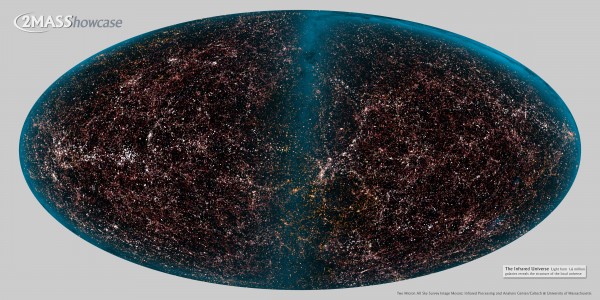
Now, if you're an astrophysicist, you might ask yourself how these nearby galaxies are distributed. Are they regularly distributed? Randomly distributed? Clumped together?
Each of these means something different. Regular means, if I drew a 3-D grid in space, each box would have roughly one galaxy in it. Random is what you'd get if you blindfolded yourself and placed down points, completely at random. Andclumped is what you'd get if the galaxies preferentially clustered around a few points, and away from certain others.
And as you can tell with a simple, visual inspection, the galaxies are definitely clumped or clustered together in the Universe. But this is troubling, and it should be troubling! Because initially, the Universe started off extremely uniform. And if we want to measure the departures in space from uniformity, we can do so when the Universe was only about 0.0028% of its current age!
This famous image -- of the anisotropies in the cosmic microwave background -- show slightly overdense regions (in blue) and slightly underdense regions (in red). The big conundrum?
These fluctuations are random, not clumped.
So, you may ask yourself, "Well, how did I get here?"
In other words, you'll get something that's clumped together instead of random. But we can go further, and ask, "What does it take to get the right amount of clumping?"
If all you had was normal matter -- protons, neutrons, and electrons -- then when they tried to collapse, the photons (radiation) in the early Universe would push back on them, and there would be certain scales that structure was completely suppressed on.
And that doesn't happen.
But if all you had in your Universe was dark matter, you'd just get these big, diffuse halos of dark matter, with no galaxies at all. Moreover, if you want to get small halos in addition to large ones, you need your dark matter to be cold, or at a lower temperature (moving at a slower speed).
The structure we make in the Universe is very sensitive to the mixture of normal matter, dark matter, and photons that we have. Too much normal matter, and the "wiggles" in the above diagram are too large. Too much dark matter, and the wiggles disappear. And if the dark matter is too hot, the graph gets truncated on the right-hand side. So when we go to the data, what do we learn?
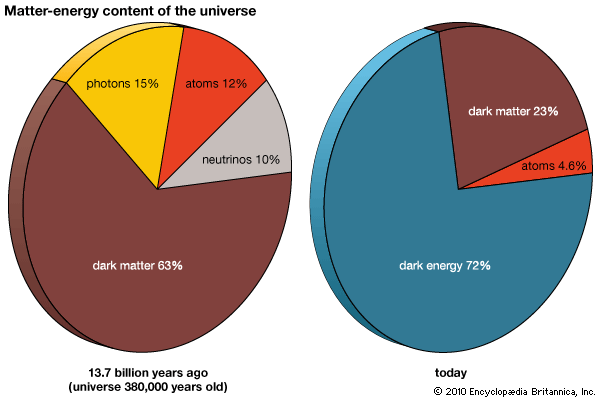
We learn how much normal matter (i.e., atoms), radiation, dark matter, and (even) dark energy are in the Universe! You change any of these ratios by even a few percent, and the Universe would look entirely different.
What's remarkable is that the numbers we get -- looking at this large-scale structure in the Universe -- are the same numbers we get for the amount of dark matter, dark energy, and normal matter in the Universe from looking at the cosmic microwave background or at supernovae!
This is one of the most compelling arguments for our story of dark matter in the Universe, with no other explanation coming even close to reproducing the predictions of dark matter.
So you may ask yourself, "How did I get here?" And the answer is that dark matter and dark energy brought all of it -- the paltry 4.6% of the Universe that is you, the Earth, and all the stars and galaxies in the Universe -- here.
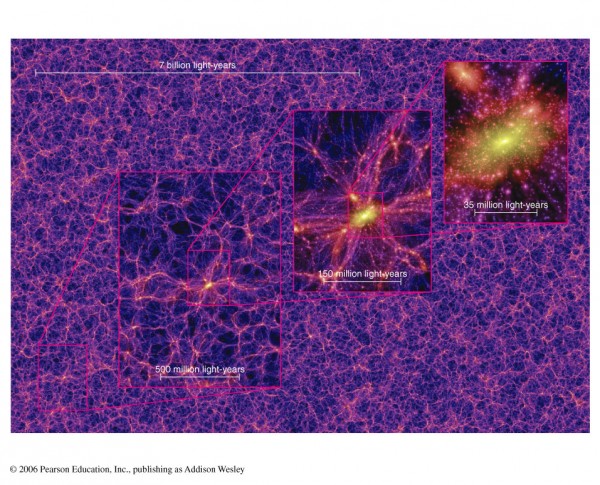


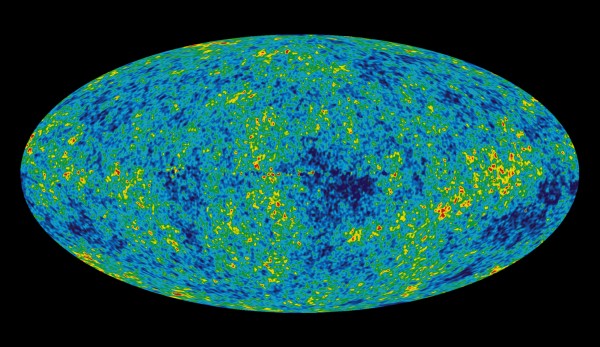


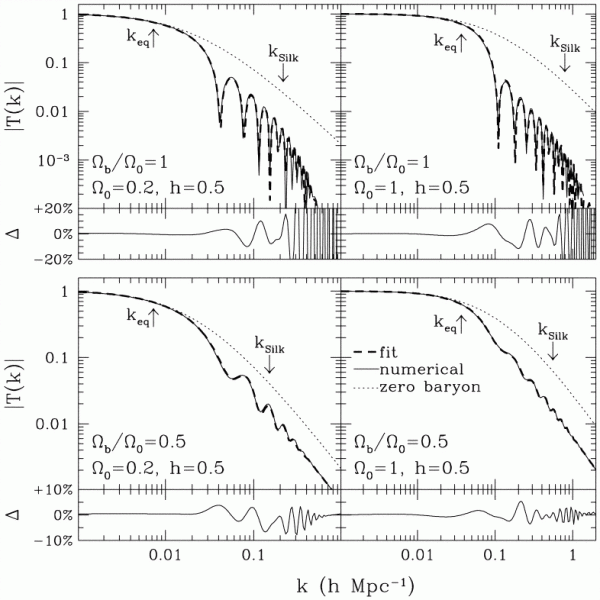
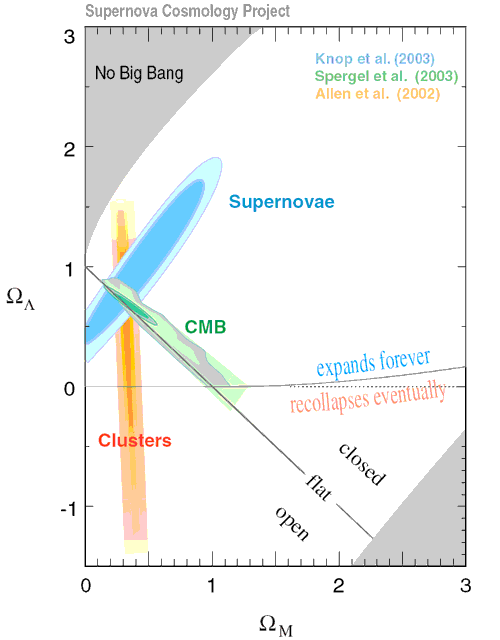
Beautifully readable. I still don't quite know what dark matter and dark energy are, but I begin to understand the arguments for why they must exist.
I'm not gonna pretend to understand this completely, but it's a great read and the images are stunning.
NO WAY!
I ALWAYS ALWAYS thought about the universe when I heard that Talking Heads song!
I always think:
"You may find yourself, sitting on huge rock, floating in the universe" etc
Very nice post about the existence for Dark matter and Dark Energy! Taking complex material and making it comprehensible is an art form!
another very well done post. you have a fantastic knack for combining pop culture, great videos, and clear text. Thanks.
Looks like a mycelium or even neuronal network. Very well told story.
Fascinating! But we're left to wonder about those two pie-charts... why is the ratio of dark matter/energy to regular matter so different then compared to now? Can we conclude regular matter/energy becomes dark over time?
Is dark matter the famous pixie dust everybody talks about?
I'm with Dan -- what is with those pie charts? The dark energy shift I think I understand. Dark energy remains at a constant density regardless of the size of the universe, so as the universe grows it grows relative to the matter, which is conserved. And I suppose the photons can be explained as the universe cooling down. But what happened to the neutrinos?
How different is the matter energy content of the universe now compared to millions of years ago. Unbelievable how we and our galaxies is that tiny 4.6% as shown on that pie chart. Photons and neutrinos have definitely disappeared?
Does that mean that Dark Antimatter is annihilating itself so that over time it's converted to Dark Energy?
I don't think the pie charts effectively illustrate the expansion of the Universe and how 63% becomes 23% with (no significant change?) in the amount of dark matter.
Not that I think their was no change, just that it isn't clear from the Pie.
The pie's are of the whole Universe at two specific times, at specific sizes. When the size (of the Universe) gets bigger by the increase of DE, the relative percentage of matter constituents go's down, that's not to say their is less than before, it just says, As a whole neutrinos are a certain percentage compared to the more abundant DE.
The above pie's focus is on showing the scale of expansion relative to the theoretical force of Dark energy.It is not accurate enough to show diminishing or increasing aspects between types of mass and is not the intent.
Personally, I think DM can become normal matter over such long time scales,(in contrast to accepted science) but then who am I?
We need to find specific dark matter particle(s), or a mechanism that mimics dark matter.
Experiments like IceCube or KM3Net might find specific evidence (i.e. dark matter) or not. But without specific experimental/observational evidence; dark matter is a hypothesis more akin to Newton's action at a distance than Zeilinger's quantum teleportation.
Kontrollerde ele gelen bir kitle, meme baÅından gelen kanlı akıntı, meme cildindeki çekilmeler, ciltteki kızarıklıklar ve portakal kabuÄu görünümünün meme kanserinin belirtileri olduÄunu söyleyen Kapkaç, böyle bir durumda hemen uzman doktora baÅvurulması gerektiÄini vurguladı
Hekimlere düÅen görevin toplumda hastalıÄın farkındalıÄını arttırmak olduÄunu ifade eden Kapkaç,â HastalıÄı erken yakalayarak kolay ve etkili bir Åekilde tedavi etmek gerekir. Hekimlere düÅen görev ise bu nedenlerle kendilerine baÅ vuran kadınları eÄer 40 yaÅını aÅmıÅlarsa muayeneden sonra mutlaka bir mamografi merkezine göndermektir. Yani hekimlere düÅen görev bu noktada budur. Ãünkü meme kanserine baÄlı ölümleri mamografiyle yüzde 25-40 oranında azaltmak mümkündürâ Åeklinde konuÅtu
So coming from an extreme novice to astrophysics, why can the departures from uniformity only be measured when the universe is 0.0028% of it's current age?
Whatever theories and conclusions science decides upon depends entirely on the premise adopted in the initial stage.
If there are two possible premises to choose from, such as (1) Dark Matter is gravitationally attractive to baryonic matter, or (2) Dark Matter is gravitationally repulsive, to baryonic matter, each premise being quite capable of developing internally consistent theories, and the majority of scientists decide on one premise, to the exclusion of the other, then the premise that was not adopted needs must, henceforth, be totally ignored.
Thatâs the kind science weâve become familiar with since before, during and after the time of Galileo.
None of the near spherical halo shapes that surround most large galaxies, the non-interaction between baryonic matter and DM, the apparent non-attraction of DM to black holes, makes any sense in the context of attractive DM.
From my standpoint, a major irritant is the frequency with which some cosmologist or other comes out with some white noise nonsense about alleged mutual âDark Matter Annihilationâ, the evidence for which is in actual fact completely nonexistent.
Wow! This is really well done. And the image selection is great for sure. I sure love cosmology. :)
A Lang, I don't know if this is referring to your point.
http://www.newscientist.com/article/dn18839-dark-matter-claims-thrown-i…
I'm particularly interested in your comment, "Whatever theories and conclusions science decides upon depends entirely on the premise adopted in the initial stage... then the premise that was not adopted needs must, henceforth, be totally ignored."
Does this apply to the big bang theory versus some cyclic universe theory also?
Your comment seems to go beyond a call for physical evidence of dark matter; you seem to suggest that somehow the physical evidence will be biased (e.g. that the "dark matter hypothesis" is fundamentally unfalsifiable).
Help, point me, to understand what you are suggesting. Thanks.
E@15: That was the point in time when the universe cooled down enough to become transparent to photons. You can sort of think of the cosmic microwave background as a snapshot of the last moment the universe was still opaque. (Much like when you look up at the sky, you can see the bottoms of the clouds, but not the inside of the clouds, or the air between them and you.)
Well, no, it is not. (And the eternal student in me get shivers when I hear such blatant falsehood, whether deliberate or not.)
Newton's action at a distance was a hypothesis that *failed* spectacularly when put to the test (say, speed of gravity), and that lead to relativity.
Dark matter is a hypothesis that *succeeded* spectacularly when put to the test (say, Bullet cluster), and moreover showed itself fruitful as a necessary part of standard cosmology. I believe the post describes this at length.
Also, there is no "mimic" of dark matter, we know its properties as they pertain to standard cosmology. What you need to make us believe in "mimics" is to come up with new, testable properties that deviates from that.
How did we get here is a universal question and a universal debate. But,why are we the only species that is concerned about our existence. Morover, what is the importance of knowing how we got here. If we never asked this question,would there be any religous or non religous belief? Would science, as we know it today exist.
Since every belief begins with explaining how we got here and science trys to discover the origin of man, the age of the earth, and the origin of the universe, we would exist in the same state of our so-called primative ancestors. But at least we would not be a threat to the earth and the animals.
Well, we are probably the only species (that we know of) that asks that question because we may be the only one with a truly deep understanding of death and the concept of non-existence.
That causes us to question what happens after we die because we have a bit of a self-interest in such a question and its answer.
That then leads to the corollary question, where did we come from, because perhaps an answer to that question will help us answer where we go, if anywhere, after we die.
I don't think any entity with our deep understanding of death can escape thinking about where we come from.
I don't think any entity with our deep understanding of death can escape thinking about where we come from.
http://www.tatilhikayesi.com/tatil/tatil
I don't profess to understand this cosmology, but I love it. As for the matter of my impending death, no problemo. I think like Mark Twain on this subject. He was not at all inconvenienced by the fact of his non-existence for all of those centuries prior to his birth. By inference, nor was he - -or I , bothered by non-existence in the future. Our lives have only the meaning we give them - nothing more.
wow
Can you put it in short simple terms for me please? I am doing a presentation on this stuff Help! Thanks xx
Since the mystery of the afterlife is wrapped up in the mystery of life's origins,perhaps we should be just as concern about why we question our existence. First we asked the biological question, next we ask the geneaology question and then we ask how did man get. after that we asked the meaning of life, and what happens after death.